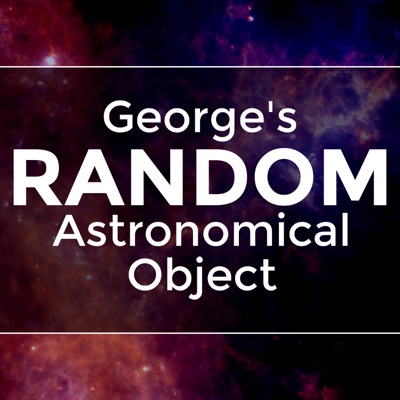Discover George's Random Astronomical Object
George's Random Astronomical Object

George's Random Astronomical Object
Author: George Bendo
Subscribed: 15Played: 224Subscribe
Share
© George Bendo copyright 2019-2024
Description
George's Random Astronomical Object is a biweekly astronomy podcast featuring science discussions about astronomical objects at randomly selected locations in the sky. The wide range of topics discussed in the show include stars, variable stars, variable variable stars, supermassive black holes, ultracool dwarf stars, exoplanets, howler monkeys, infrared radiation, acronyms, more acronyms, starbursts, measurements of less than 12 parsecs, jellyfish galaxies, diffuse ionized gas, and general overall weirdness.
163 Episodes
Reverse
The pulsar PSR J1022+1001 is one of a small subclass of pulsars named millisecond pulsars because they rotate one every few milliseconds.
The lenticular galaxy NGC 1172 contains two different populations of globular clusters, which indicates something about the history of the galaxy.
Dy Pegasi is an SX Phoenicis type variable star, and SX Phoenicis type variable stars are a subset of Delta Scuti type variable stars, and this episode explains why that is confusing but what it also actually means.
The spiral galaxy NGC 3718 has an unusually weird spiral shape, which belies its unusual history.
While amateur astronomers know that Albireo is a very spectacular-looking double star, professional astronomers are more interested in the dynamical complexities of Albireo's two star systems.
The gamma ray burst GRB 020819 took place in a galaxy containing so much light-obscuring interstellar dust that people initially misidentified which galaxy contained the burst.
The nearby Sun-like star HD 69830 may have three exoplanets orbiting it, but astronomers seem more focused on trying to understand a hard-to-explain dust disk in the star system.
Z Ursa Minor belongs to a class of variable stars that occasionally produce puffs of dust, but this is not the weeirdest thing about them.
The nearby face-on spiral galaxy Messier 101 is one of the most popular galaxies in the sky for astronomers to study, particularly in terms of studying the relative abundances of various elements within the galaxy.
A 0535+26 is a rather unusual star system called a Be high mass X-ray binary that periodically produces bursts of X-ray emission.
Hen 2-113 is a rather unusual planetary nebula that formed not when a Sun-like star died but when a large, massive, and extraordinarily hot Wolf-Rayet star blew away its outer hydrogen layers.
The quasar PKS 2126-158 has been popular to observe because astronomers can see many different things between the quasar and Earth, including an entire cluster of galaxies, that are absorbing light from the quasar.
Beta Ceti is a relatively close giant star where helium fusion has been triggered in its core, but it's a bit unusual compared to other stars that have reached this stage in their evolution.
Wolf 1069 is another nearby red dwarf with an exoplanet, but this time, the exoplanet is more likely to harbor life than other nearby red dwarfs with exoplanets that I may have discussed in previous episodes.
The globular cluster Messier 54 is not part of our galaxy but actually the nuclear stellar core of a dwarf galaxy that has nealy been completely gravitationally torn apart by the Milky Way.
DI Pegasi is a star system with two eclipsing stars in its center that orbit each other every 17 hours and 5 minutes and two smaller stars on very wide orbits that gravitationally tug on the central two stars, which has the effect that the variability of the star system's brightness seems to change over decades of time.
Abell 1142 is a peculiar cluster of galaxies that has formed from the merger of two smaller clusters, and its center contains nothing but gas.
SN 2002cx was the first supernova ever identified in a subclass of objects now called Type Iax supernovae.
PSR J1518+4904 is one of the very few identified double neutron stars, and it has provided opportunities to perform unique measurements on the objects.
The stars in the open cluster NGC 6253 contain abnormally large amounts of elements heavier than hydrogen and helium, and no one is quite certain why.






